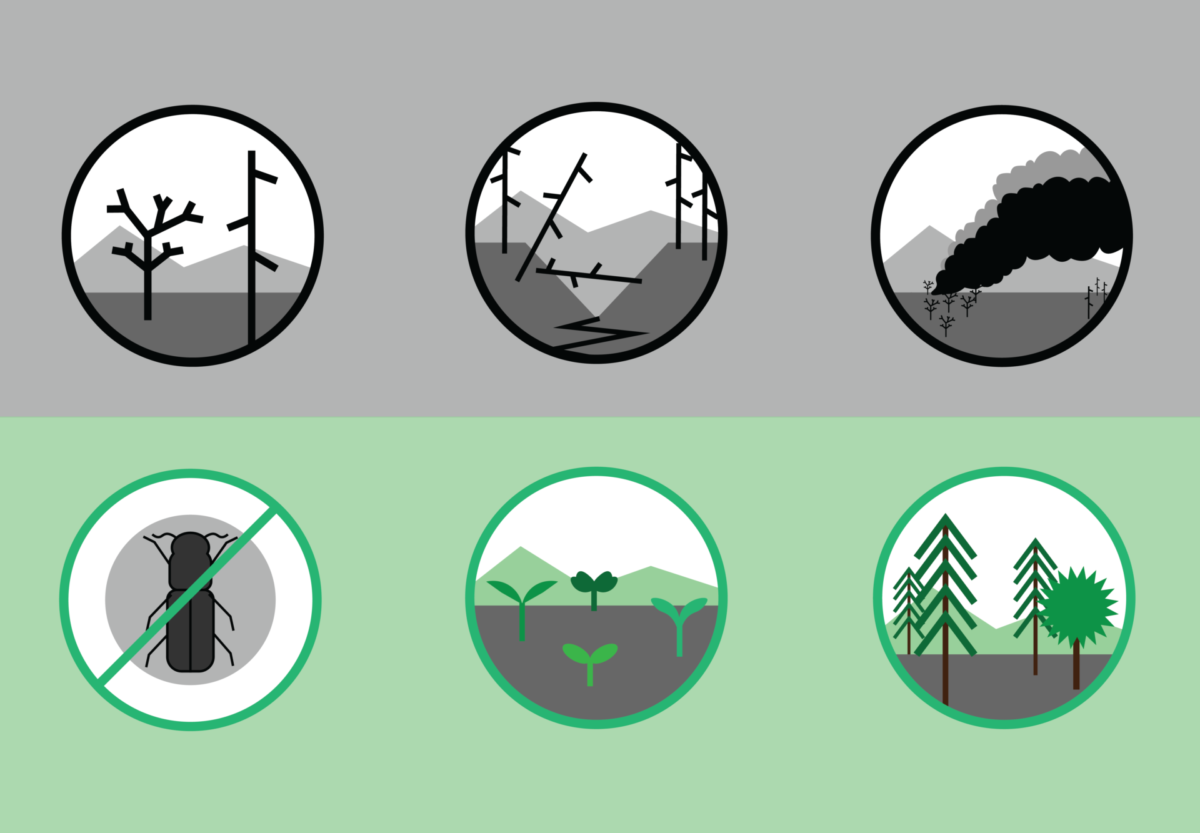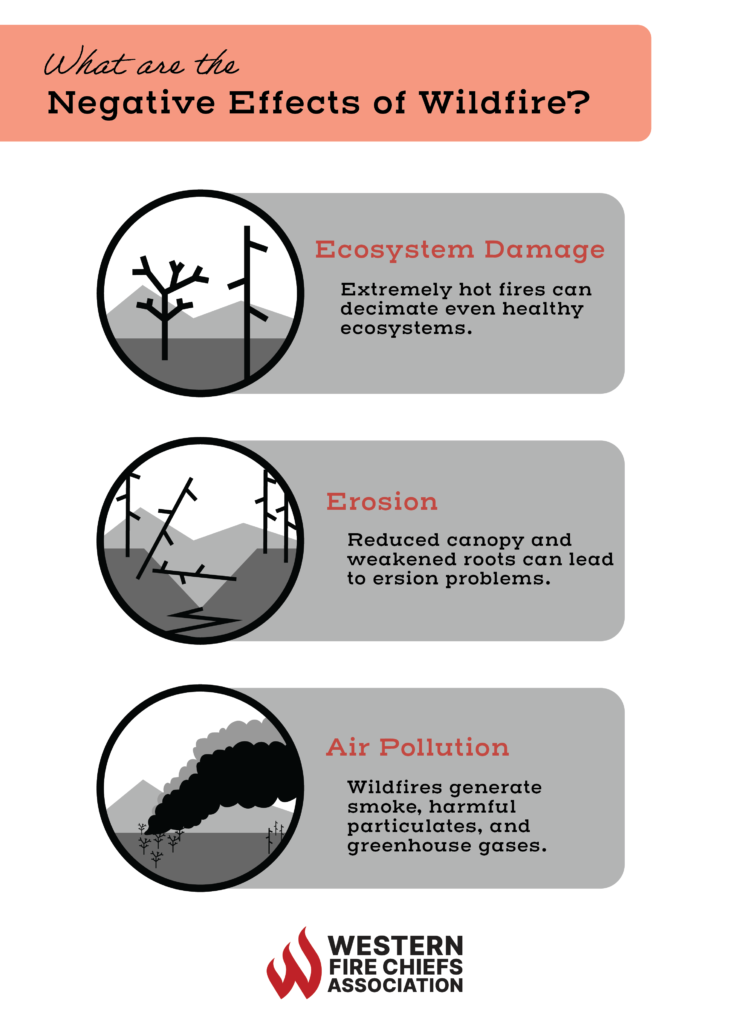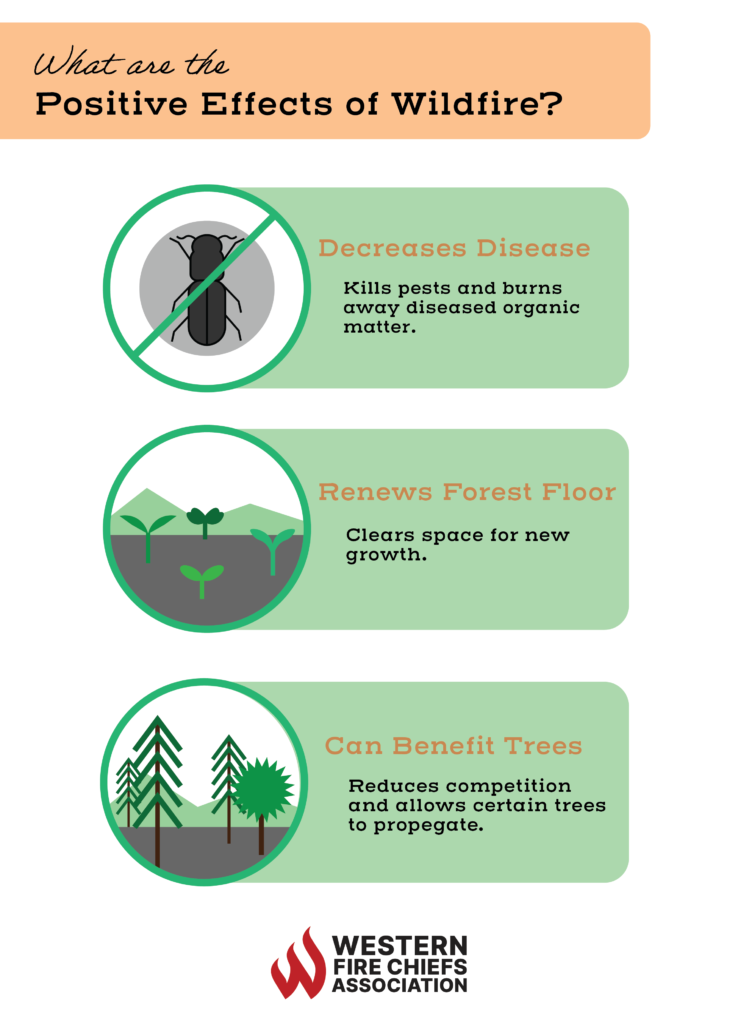Fire Pit Safety Tips
Stay safe around the campfire with tips from the Western Fire Chiefs Association. Learn essential precautions and practices for a worry-free outdoor campfire.
Explore both the positive and negative effects of wildfires on the environment with expert knowledge from the Western Fire Chiefs Association (WFCA).
Published:July 18, 2022
Edited:March 4, 2024

Each year, the effects of wildfires can be felt more intensely around the globe. Since 1983, the National Interagency Fire Center (NIFC) has documented more than 70,000 wildfires per year. The actual total may be higher, as some small fires can extinguish themselves before detection.1
At the same time, the number of acres affected by wildfire is growing. Of the areas burned each year from 1984 to 2018, severe damage has risen from 5% to 23%.1 The ten years with the highest number of acres burned have all happened since 2004. This period coincides with the global warming data that show many of the warmest years on record have also happened within the past two decades.
Although frightening and dangerous, the effects of wildfires on the environment range from extremely destructive to critically important for ecosystem health.
Wildfires are frightening and hazardous events. Although most people and some animals can flee from the flames, plants, and soil do not have this option. Below are three examples of the negative effects of wildfire on the environment:
All of Earth’s life forms rely on the planet’s natural cycles to create food, shelter, and a habitable climate. An ecosystem is a community of plants and animals in a specific location, whose collective biological processes and complex interactions create a life-sustaining network.
A healthy forest, for example, is a generous and elegant system that recycles nutrients, purifies the air, retains water, builds soil, and supports an abundance of life. Strong enough wildfires can interrupt many of these processes, damaging or destroying plants and soil, and killing or displacing wildlife.
Depending on the level of destruction, once a wildfire leaves an area, root stabilization provided by plants may no longer be viable. In such cases, erosion problems can affect the land and local water sources.2
Unstable soil can contribute to mudslides, flooding events, and land degradation. Damaged soil also loses its ability to sequester carbon dioxide.
The 2020 wildfire season in California likely offset several decades of air quality gains. With more than 9,000 events tracked in the state that year, more than 4.3 million acres burned.3
Mariposa County in California typically enjoys some of the cleanest air in the state. In 2020, it led the United States in annual average concentrations of fine particulates. The readings averaged 22.6 micrograms per cubic meter, which is over four times what the World Health Organization (WHO) recommends.4

Although they can devastate forests and homes alike, the effects of wildfires on the environment can also be positive, and even essential. Below are three positive effects of wildfire on the environment:
Numerous insects and pests live in forested areas. Wildfires help to clear out the diseases they cause, reducing future damage.
Many tree diseases are untreatable and can affect foliage, branches, stems, and roots.5 Wildfires work to eliminate diseased plant material, helping to prevent pathogens from spreading.
As a forest ages, trees provide an increasingly shady canopy. The dense canopies of older forests prevent sunlight from reaching the ground. In heavily wooded areas, even precipitation may fail to reach the soil below the trees.
After a wildfire that has burned away smaller trees or cleared some of the canopy, more sunlight and rain can reach the ground, encouraging new plant life. If a wildfire is not too intense, it can leave roots undamaged, stimulating stronger regrowth after the fire has passed. New and reemerging plants serve as an important source of food and habitat and work to renew the cycle of life in the affected area.6
Although some wildfires can completely devastate forested areas, many do not burn hot enough to damage mature trees permanently. Bark works like armor, shielding against pests, flames, and other harmful forces.
As long as a wildfire is not too hot and the conditions are not too dry, the fire will generally clear cluttered underbrush from the forest floor while causing minimal damage to healthy, mature trees. Additionally, certain plants require fire as part of their natural life cycle, such as the majestic Giant Sequoia.7

Climate change is happening as a result of anthropogenic fossil fuel burning.8 Enough greenhouse gas has accumulated in the atmosphere that we are now experiencing its effects dramatically, year over year. The impacts of climate change are projected to worsen and intensify indefinitely if we do not make swift, sweeping changes to the way we live. Since climate change exacerbates the risk of extreme fires, reducing the negative effects of wildfires on the environment also requires fighting climate change.
As an individual, the easiest way to offset climate change is to reduce greenhouse gas emissions from your daily activities. A few examples are riding your bike to work, eating locally grown foods, taking public transportation or carpooling, or using an electric vehicle.
Another way to help is to more conscientious about your energy usage. For example, if everyone replaced their incandescent bulbs with LED alternatives, the quality of light would remain the same while energy consumption would decrease. By doing so, each person could reduce their home’s carbon emissions by up to 40kg per year.10
Using recycled products and reducing waste can also help the environment. Halting the production of all virgin goods is not an immediately feasible solution, but we can advocate for closed-loop manufacturing practices and push for cleaner production methods. The impacts of traditional industry on the environment are significant, and could be seen clearly when manufacturing stopped during the 2020 COVID-19 pandemic lockdowns. When factories were not operating, many areas benefited from the cleanest air they had seen in decades.11
While there are small steps we may take as individuals to address climate change, our real power lies in collective action. Reining in the biggest contributors to the climate crisis requires intervention at the legislative level, and will only happen if we make our voices heard. Consider making a call or writing to your elected officials to ask for decisive action in response to the climate crisis. Vote for representatives who will prioritize addressing climate change, and who are not sponsored by major polluters. Talk about climate change with your friends, family, and neighbors, and take action to address your impact as a community.
If we allow climate change to continue harming the environment, the risk for more devastating wildfires will continue to increase, among other life-threatening problems. We can each do our part to limit these risks, preserve our land, and protect our forests. What steps can you and your community take today to ensure a brighter tomorrow for all?
The Western Fire Chiefs Association (WFCA) is committed to our role as advocates for the fire service, and we will continue to develop and promoting cutting edge tools and technology to respond to the new age of wildfires.
Stay safe around the campfire with tips from the Western Fire Chiefs Association. Learn essential precautions and practices for a worry-free outdoor campfire.
Discover essential firework safety tips to ensure a dazzling display without accidents. Learn how to celebrate responsibly with expert guidance from WFCA.
Explore the role of AI in wildfire prediction with guidance from the WFCA. Learn how advanced algorithms and data analytics enhance early detection and response.